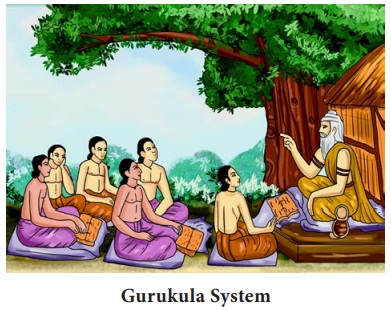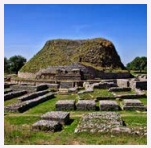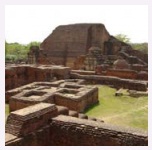Educational Development in India | Chapter 5 | History | 8th Social Science - Education in Ancient India | 8th Social Science : History : Chapter 5 : Educational Development in India
Chapter: 8th Social Science : History : Chapter 5 : Educational Development in India
Education in Ancient India
Education in Ancient India
The historical sources provide the
information that from very early times, the tradition of teaching and learning
had been in vogue in India. The concept of Education might have originated from
the Vedas. The literal meaning the Sanskrit word ‘Veda’ is knowledge and the
word derived from the word Vid, which means ‘to know’. Our ancient education
system evolved over many centuries and focused on the holistic development of
the individual by taking care of both the innate and latents capacities. It
emphasised on values such as humility, truthfulness, discipline, self-reliance
and respect for all creations.
Sources of Learning
You must have heard the names of Panini,
Aryabhata, Katyayana and Patanjali. Their writings and the medical treatises of
Charaka and Sushruta were also some of the sources of learning. Various
disciplines such as history, logic, interpretation, architecture, polity,
agriculture, trade, commerce, animal husbandry and archery were taught.
Physical education too was an important curricular area and pupils participated
in games and recreational activities. The Gurus and their students worked
conscientiously together to become proficient in all aspects of learning.
In order to assess students' skills,
literary debates were organised. Students at an advanced stage of learning
guided younger students. A system of peer learning was also practiced, like you
have group/peer work.
Ancient Education System in India: A Way of
Life

In ancient India, both formal and
informal education existed. Indigenous education was imparted at home, in
temples, patashalas, and gurukulas. There were people in homes, villages and
temples who guided young children in imbibing pious ways of life. Temples
played a vital role in imparting education and served the centres of learning.
Students went to viharas and universities for higher studies. Teaching was oral
and students remembered and meditated upon what was taught in the Gurukulas.
Many of these Gurukulas were named after the sages. Situated in forests, in
serene and peaceful surroundings, hundreds of students used to learn together
in Gurukulas. During the early period education was imparted by the teacher
(Guru/Acharya) to the pupils who gathered around him and came to live in his
house as members of his family. This was known as Gurukula system of eduation.
During that period, the gurus and
their shishyas (pupils) lived together helping each other in day- to-day life.
The main objectives was to have complete learning, leading a disciplined life
and realising one's inner potential. Students lived away from their homes for
years together till they achieved their goals. The gurukula was also the place
where the relationship between the guru and student strengthened with time.
Many monasteries and viharas were
set up for monks and nuns to meditate, debate and discuss with the learned for
their quest for knowledge during this period. Around these viharas, other
educational centres of higher learning developed, which attracted students from
China, Korea, Tibet, Burma, Ceylon, Java, Nepal and other distant countries.
Viharas and Universities
Buddhist Period
Taxila was an ancient
Indian city, which is now in north-western Pakistan. It is an important
archaeological site and the UNESCO declared it as a world heritage site in
1980. Its fame rested on the university where Chanakya is said to have composed
his Arthashastra. Archaeologist Alexander Cunningham discovered its ruins in
the mid-19th century.

The Jataka tales, accounts given by
Hiuen Tsang and I-Tsing (Chinese scholars), and other sources tell us that
kings and society took an active interest in promoting education. Through
monasteries and Viharas Buddhist scholars carried out the educational work. As
a result, many famous educational centres came into existence. Among the most
notable universities that emerged during that period were situated at Taxila,
Nalanda, Valabhi, Vikramshila, Odantapuri and Jagaddala. These universities
developed in connection with the viharas. Those at Benaras and Kanchi developed
in relation with temples and became centres of community life in the places
where they were situated. These institutions catered to the needs of advanced
level students. Such students joined the centres of higher learning and
developed their knowledge by mutual discussions and debates with renowned
scholars. Not only that, there was also occasional summoning by a king to a
gathering in which the scholars of the various viharas and universities would
meet, debate and exchange their views.
Role of the Teacher
Teachers had complete autonomy in
all aspects from selection of students to designing their syllabi. When the
teacher was satisfied with the performance of the students, the course
concluded. He would admit as many students as he liked and taught what his
students were keen to learn. Debate and discussions were the primary methods of
teaching. Teachers were assisted by their advanced level students.
The ancient Nalanda
University was a centre of learning from the 5th century AD (CE) to 12th century
AD (CE). Located in present-day Rajgir, Bihar. Nalanda was one of the oldest
universities of the world and UNESCO declared the ruins of Nalanda Mahavihara a
world heritage site. The new Nalanda University is envisaged as a centre of
inter-civilisational dialogue.

Related Topics